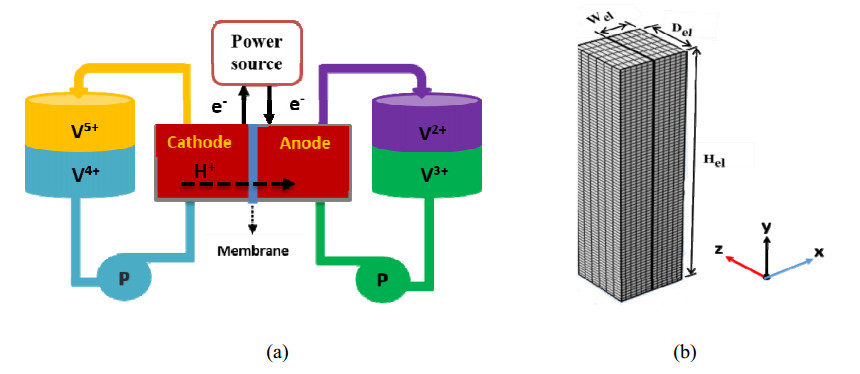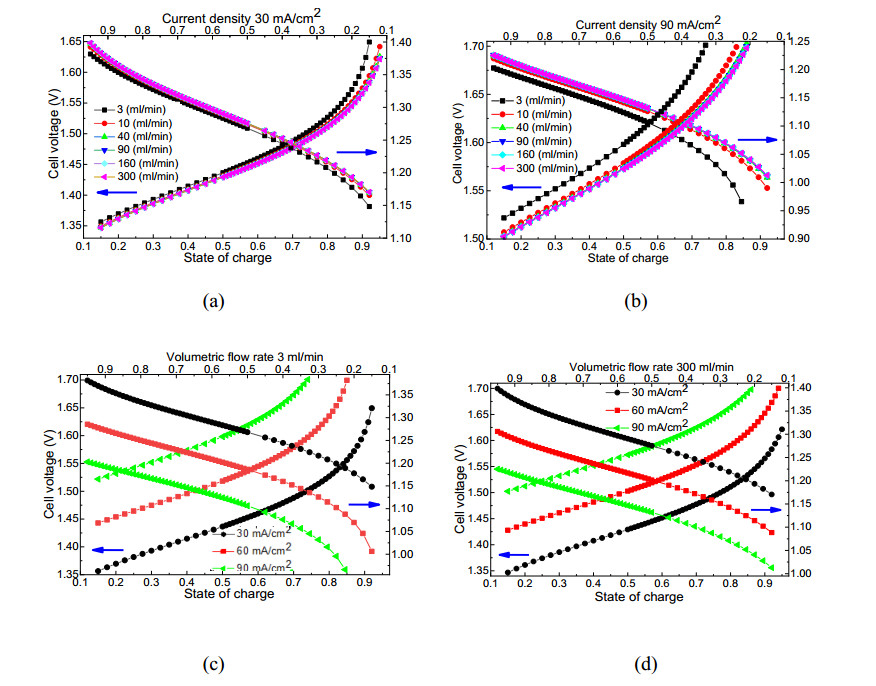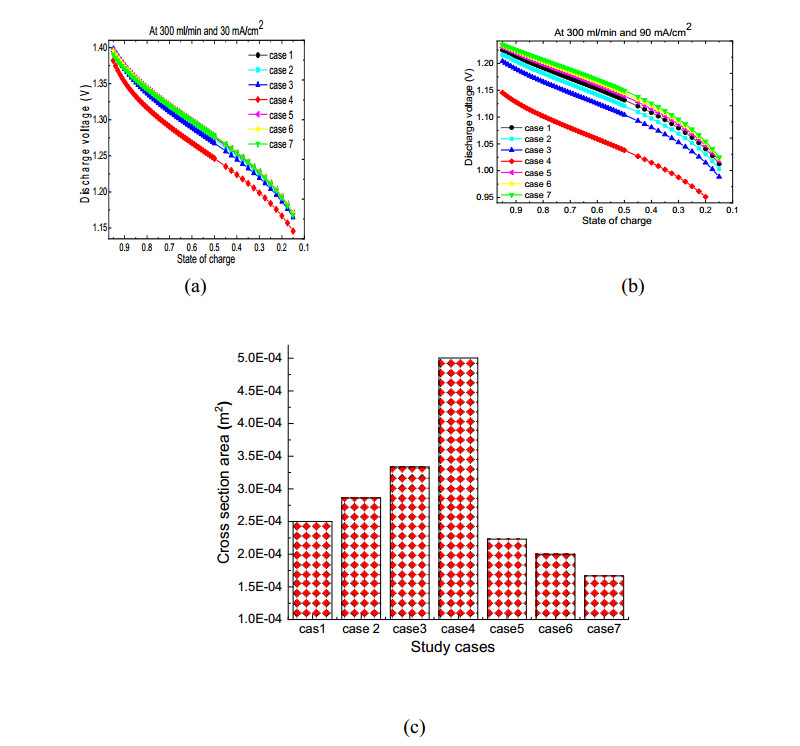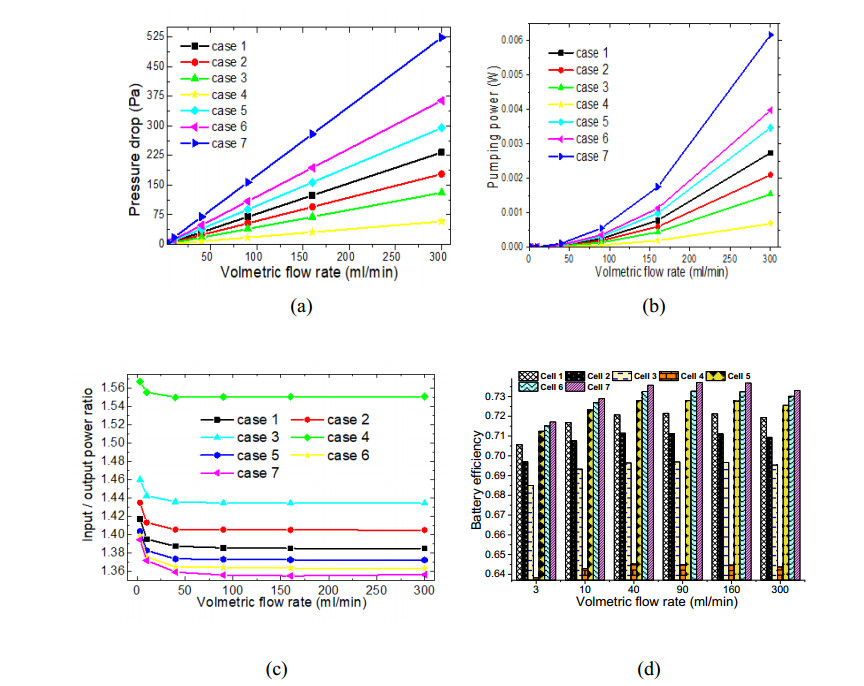The vanadium redox flow battery (VRFB) is being investigated as one of the promising candidates for large-scale energy storage systems. In the present work, the role of electrode shape on a single VRFB cell performance has been studied through a 3D numerical model. The model accounts for the coupling between electrochemistry and fluid mechanic physics. Seven cases of electrode configurations at the same volume size (10 cm3) have been simulated to investigate the overall battery performance. Results from the simulation show that the configuration (case 7) has the best battery efficiency, while the worse one is (case 4) under the same operating conditions, e.g., 71.72% and 63.82%, respectively. Also, the ratio of output to input power for (case 7) is 0.72, while 0.63 for (case 4). In addition, there is an optimal flow rate for each case to get maximum battery efficiency, which means a balance between electrochemical reactions and pumping losses is required. Overall, adopting a thicker electrode (cases 2, 3 and 4) results in lower battery performance due to the poor voltage responses. One feature of the introduced model is its capability to predict the performance of most flow batteries cell configurations.
The rapid development of science, technology, and engineering, and their central role in our society, are often intrinsically correlated with the deep understanding and high-quality applications of advanced mathematics. Science, technology, engineering, and mathematics are united in the popular acronym STEM, and in fact we believe that the mutual support between all the disciplines related to mathematics and engineering can play the role of a solid "stem" sustaining the growing petals of our ever-changing society.
This interplay between engineering and mathematics occurs at different levels, such as the process of formalizing, testing, and confirming models that describe complex phenomena, the analysis of data, the quantitative characterization of patterns arising in nature, the precise prediction of events partially governed by chance, the invention of codes and algorithms for fruitful interactions between humans and machines, the establishment of coherent frameworks for strategic decision making - just to name a few scenarios.
We found therefore the need to provide an inclusive forum to allow for an open dialogue across disciplinary boundaries, focused on top quality mathematics and engineering, which overcomes the rigid distinction between "pure" and "applied" mathematics, so that scientists and mathematicians can discuss and corroborate mathematical theories and methods in view of their applications in engineering.
Mathematics in Engineering is indeed an interdisciplinary journal focused on high-quality applications of mathematics to science and engineering. The journal publishes innovative articles with solid theoretical foundations and concrete applications, after a rigorous peer-review process.
All areas of theoretical and applied engineering are within the scope of the journal and the relevant applications include, but are not limited to, materials science, fluid and solid mechanics, thin films and interfaces, phase transitions, image and signal processing, computational intelligence and complexity, machine learning, data analysis, applied physics and biology, social sciences, environmental engineering, biomedical engineering and mechanobiology, chemical and mechanical engineering, electrical engineering and applied electromagnetics, metamaterials, optics, robotics, and industrial applications.
The mathematical methodologies include numerical analysis, differential equations, calculus of variations, dynamical systems, statistical mechanics, deterministic and stochastic models.
To achieve the highest standards, we have invited many world leading researchers to take part in the Editorial Board: we are very indebted to them for their availability and we are sure that they will be the cornerstone towards the success of the journal.
We are also indebted to the Authors who have contributed to the inaugural issue, as well as to the ones who will contribute to the subsequent issues. They provided the strongest possible foundation for this challenging enterprise.
Of course, special thanks go to the Referees, who professionally contribute to help achieve and maintain the high standards of the journal with their hidden, but indispensable, service.
We would also like to thank the Readers of this journal. They are the final target of our product and the ultimate judge of the success of the journal. We hope that they will share the same scientific excitement for this new academic adventure.
You are cordially invited to participate as Authors, Referees, and Readers.
The journal is completely free of costs for both Authors and Readers.
Antonio DeSimone and Enrico Valdinoci
Editors-in-Chief

















 DownLoad:
DownLoad: